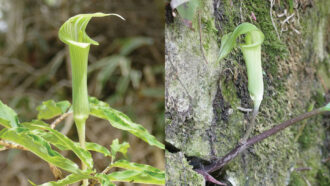
Fake — and fatal — invitations to romance could be the newest bit of trickery uncovered among some jack-in-the-pulpit wildflowers.
The fatal part isn’t the surprise. Jack-in-the-pulpits (Arisaema) are the only plants known to kill their own insect pollinators as a matter of routine, says evolutionary ecologist Kenji Suetsugu of Kobe University in Japan. The new twist, if confirmed, would be using sexual deception to woo pollinators into the death traps.
Until now, biologists have found only three plant families with any species that pretend to offer sex to insects, Suetsugu says online March 28 in Plants, People, Planet. But unlike deceit in jack-in-the-pulpits, those other attractions aren’t fatal, just phony.
The orchid family has turned out multiple cheats, some so seductive that a male insect leaves wasted sperm as well as pollen on a flower. Yet he doesn’t get even a sip of nectar (SN: 3/5/08; SN: 3/27/08). Similar scams have turned up among daisies: A few dark bumps that a human in bad light might mistake for an insect can drive male flies to frenzies on the yellow, orange or red Gorteria petals. Enthusiasm wanes with repeated disappointment though (SN: 1/29/14). And among irises, a species dangles velvety purple petals where deluded insects wallow.
Until now, luring pollinators with false offers of insect sex has turned up in only three plant families. Hundreds of orchids cheat (including Ophrys speculum, left). So does a daisy with alluring insect-like petal bumps (Gorteria diffusa, middle) and an iris (Iris paradoxa, right) with some dark dangling petals.Steven Johnson (daisy) and Jorun Tharaldsen (orchid, iris) from D.C.J. Wong, J. Perkins and R. Peakall/Frontiers in Plant Science 2022
Two jack-in-the-pulpit species in Japan have now raised suspicions that their family, the arums, should be added to the list of sexual cheats. To visually oriented humans, the 180 or so Arisaema species look like just a merry reminder of evolution’s endless weirdness. Some kind of flappy canopy, sometimes striped, bends over a little cupped “pulpit” with a pinkie-tip stub or mushroom bulge of plant flesh peeping over the rim. Below the rim, swaths of flowers open in succession — male blooms overtaken by flowers with female parts — as the plant grows from slim young jack to big mama.
These oddball flowers depend mostly on pollinators that deserve a much bigger fan base: fungus gnats. These gnats, small as punctuation marks and hard to identify, are true flies. But don’t hold that against them. They don’t stalk picnic spreads or buzz-thump against windows. Pollinating gnats “are very frail,” Suetsugu says, and their wings make no noise a human can hear.
Nor can a human always smell what draws fungus gnats. It’s clear, though, that the varied canopied pulpits can have a strong happy hour lure for those cruising pollinators looking to meet the right gnat. This will go terribly wrong.
A tiny escape hatch deep in the trap stays open during the male phase of flowering, but that two-millimeter hole vanishes during the big mama stage. A gnat can’t overcome the slippery, flaking wax of the plant’s inner wall to climb out. So any gnat tricked twice is doomed.
Biologists had assumed that jack-in-the-pulpits seeking fungus gnats were perfuming the air with mushroomy, nice-place-to-have-kids scents. Many kinds seem to do so, but homey smells don’t explain an odd observation by Suetsugu and his colleagues. Of the important pollinator species for two Japanese jack-in-the-pulpits (A. angustatum and A. peninsulae), almost all the specks found in the traps were males.
An odor lure targeting males might mimic a come-hither scent of female gnats, the researchers propose. That’s outright fraud. Even if the hopeful males find a mate in the waxy green dungeon, they and their offspring would starve. They’re stuck in a plant with no fungus to eat. Whatever that ruinous scent is, a human nose can barely detect it, Suetsugu reports.
The notion that biologists have so far overlooked a scent important to other animals seems “more than possible” to Kelsey J.R.P. Byers of the John Innes Centre in Norwich, England. Byers’ work overturned a common assumption that monkeyflowers (Mimulus) had no scent even though hawkmoths, flying at night and known to track odors, visit the flowers.
“We’re such visual creatures,” says Byers, who studies floral scents. We can laugh at how insects mistake some off-color blob of plant tissue for a fabulous female, but we’re missing the odors. Fungus gnats, however, even look like the citizens of a smellier world, with giant guy-style antennae “like an ostrich plume on a hat.”
At least now, modern analytical lab techniques and equipment are opening up the vast sensory world of communication wafting around us. To see if even familiar plants like jack-in-the-pulpits are up to something odd, scientists need to identify the lure itself. Then maybe we’ll understand the irresistible valentine scent of a female fungus gnat.

 A new treatment could restore some mobility in people paralyzed by strokes
A new treatment could restore some mobility in people paralyzed by strokes  What has Perseverance found in two years on Mars?
What has Perseverance found in two years on Mars?  This robot automatically tucks its limbs to squeeze through spaces
This robot automatically tucks its limbs to squeeze through spaces  Greta Thunberg’s new book urges the world to take climate action now
Greta Thunberg’s new book urges the world to take climate action now  Glassy eyes may help young crustaceans hide from predators in plain sight
Glassy eyes may help young crustaceans hide from predators in plain sight  A chemical imbalance doesn’t explain depression. So what does?
A chemical imbalance doesn’t explain depression. So what does?